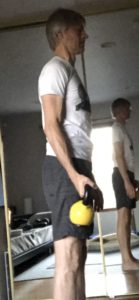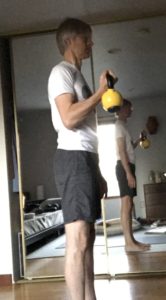Strength Training: Open vs. Closed Kinetic Chain Movement
At Alignment Lab we always encourage our clients to move more and build strength, but it is common in our practice to see clients who have developed injuries from working out at the gym with certain machines or when doing isolated exercises with weights. Many of the exercises these clients are doing involve movements that fall under the category of open kinetic chain movement (OKCM). In the interest of maximizing the health benefits of exercise and minimizing the chances of injury, we generally try to steer our clients away from (OKCM) exercises and guide them towards exercises that feature closed kinetic chain movement (CKCM).
What is the difference? OKCM exercises involve isolating a particular muscle and then challenging it with weight and or resistance by shortening (concentrically loading) the muscle. A classic example is the biceps curl, which involves picking up a weight, say a dumbbell or kettle bell with the hand, and then bending the elbow to lift the weight toward the shoulder. This exercise can be done with one or both arms, and in either case the hands are not fixed, thus the “open” kinetic chain.
CKCM involves movement relative to a fixed point. This means that some part of the body, usually a hand or a foot, is brought in contact with a stable surface such as the floor or a wall. Typically there is some amount of weight bearing involved to keep that contact point stable. The stability provided by the fixed point and the weight bearing promotes stability in the body where needed so that the exercise can be done with greater safety an efficacy.
In the example of the biceps curl, there is no fixed point. Every part of the body has the potential to move in some way during the exercise, and thus there is a lack of stability and a greater chance of strain. This exercise not only increases the chances of straining the biceps, but also the shoulder joint. Without the added stability of a fixed point the body will have a harder time keeping the humerus stable in the shoulder socket, increasing the chances of exceeding the load bearing capacity of the joint. In the end, we may end up with bigger biceps, but likely more wear and tear on the shoulders.
One solution to this problem with the biceps curl that is often used to improve its efficacy is to stabilize body by sitting on a stable seat and then placing the elbow of the working arm on a support. These changes do serve to focus the action of the arm more effectively on the biceps, but they do not necessarily make it more safe. The reason is that even though to some degree stability has increased, it has not increased in a way that eliminates potential impact on the shoulder joint.
Because there is a greater amount of force on one isolated joint, in this case the shoulder joint, this movement can easily lead to strain in the tendon of the bicep attaching to the shoulder joint. This is because mechanoreceptors in the shoulder are not well activated in this exercise. The mechanoreceptors help us feel joint position, and if they are not activated it will be more difficult to sense whether or not the shoulder joint maintains functional alignment. If the exercise is done without a functional alignment in the shoulder joint it may result in an injury.
It is important that we continue to challenge our muscles and their ability to bear weight, but preferably not at the expense of our joint health. Open kinetic chain movement (OKCM) exercises tend to increase this likelihood. Closed kinetic chain movement (CKCM) exercises on the other hand provide an opportunity to increase our strength with much less chance of injury.
While the primary difference between a CKCM exercises and an OKCM exercise is that CKCM exercises feature movement relative to a fixed point, another equally important difference is that CKCM typically feature some approximation of the joint due to the weight bearing on the fixed limb. This means that pressure, usually caused by the weight of the body, pushes the arm toward the shoulder joint, soliciting a stabilizing response in the joint. A great example would be a side plank. In this exercise one hand is fixed on the floor, and the shoulder on the same side gets approximated by the weight of the body. This helps stabilize the shoulder joint and facilitates healthy rotational movement (abduction) around the joint.
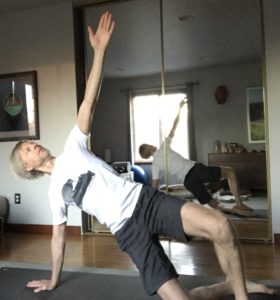 CKCM exercises have several features that account for their improved efficacy relative to OKCM exercises. First, the increased joint stability in CKCM allows for better eccentric loading of the involved muscles. Eccentric loading means that the muscles involved contract and lengthen at the same time. When a muscle contracts while lengthening, sliding motions are introduced into the fascial sheets that cover muscles groups and individual muscles. This sliding of the fascial sheets adds lubrication, nerve stimulation and a protective barrier against injury.
CKCM exercises have several features that account for their improved efficacy relative to OKCM exercises. First, the increased joint stability in CKCM allows for better eccentric loading of the involved muscles. Eccentric loading means that the muscles involved contract and lengthen at the same time. When a muscle contracts while lengthening, sliding motions are introduced into the fascial sheets that cover muscles groups and individual muscles. This sliding of the fascial sheets adds lubrication, nerve stimulation and a protective barrier against injury.
Another feature of CKCM is that it involves the motion of muscles across multiple joints. This means that these movements go beyond the isolation of one particular muscle, unlike many of the OCKM exercises commonly used in strength training (such as the biceps curl). Moving across multiple joints requires a complex synchronization of different muscle groups and therefore not only works more muscles but works them in tandem with one another, promoting strength in a functional way.
In addition, when movement occurs across multiple joints with many muscles involved it facilities co-contraction between muscles and this co-contraction, it turns out, is a more efficient way to to bear weight. When muscles co-contract with other muscles, the load is distributed across a broader area, preventing isolated muscle fatigue and decreasing shearing forces on the joints and tissues, ultimately decreasing the likelihood of strain and inflammation.
This alludes to the fact that CKCM’s are good for our tissue. These movements improve blood flow, flexibility, lymph drainage, muscle health, circulatory function and cardiovascular health in a far greater way than any open kinetic chain exercise. CKCM’s will have increased metabolic effects compared to OKCM’s, and they also promote joint health by helping to re-establish proprioception and our ability to sense joint position.
One further benefit of CKCM’s is that these movements improve function of the nervous system. This is because when more muscles and joints are moving in a complex closed-kinetic chain pattern, more nerves are firing. More nerves firing means more blood flow, better communication with the brain and thus a greater ability to dynamically move through space with intelligence.
Finally, closed kinetic chain movements are simply more functional than open kinetic chain movement in that CKCM’s are more often based on movement patterns that are innate to the human body. As babies and toddlers, each of us develops our physical function through a series of innately choreographed movements, and these movements manifest from the age of three months up to the point of walking without any instruction or mimicry taking place. This means that we don’t learn these movements from someone else, we just do them. These movements are innate in all babies, everywhere in the world, and they tell us a lot about functional motion and how the utilization of the hands and feet in a closed kinetic chain is the basis for all natural human motion.
Going back to our bicep curl exercise, let’s compare it with a closed kenetic chain movement involving the biceps and triceps using the example of a wall plank. A wall plank is basically a plank position where the head, shoulder girdle, rib cage, pelvis and legs are all in a stacked, vertical alignment with the hands on the wall standing at arm’s length. The movement involves pushing into the wall to fully extend the elbows.
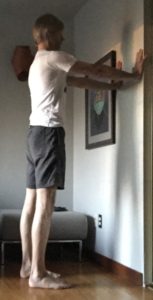 In a wall plank, the triceps contract in order to extend the arm, but at the same time the biceps co-contract in conjunction with the triceps to stabilize the elbow joint. The biceps also must lengthen to increase pressure into the wall and bear the weight of the upper body. Because the hands are fixed, a whole chain of muscles from the hands into the shoulder joints on into the back and into the abdominal muscles and down into the pelvis and legs also co-contract to help support the body’s weight.
In a wall plank, the triceps contract in order to extend the arm, but at the same time the biceps co-contract in conjunction with the triceps to stabilize the elbow joint. The biceps also must lengthen to increase pressure into the wall and bear the weight of the upper body. Because the hands are fixed, a whole chain of muscles from the hands into the shoulder joints on into the back and into the abdominal muscles and down into the pelvis and legs also co-contract to help support the body’s weight.
Once it becomes relatively easy to do a wall plank while maintaining good alignment, a full plank can be introduced involving the more challenging version of pushing up off the floor. In a full plank the biceps and triceps get worked but in a clearly functional way that facilitates our ability to lower ourselves down to the floor and lift ourselves up off the floor.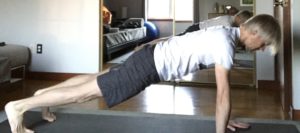
There’s a lot of press about strength training these days with ever growing evidence of its importance for human health and longevity. At Alignment Lab we’re big fans of strength training and we provide it daily with every one of our clients by teaching them mainly closed chain kinetic movements. We’ve found this approach to be ideal for promoting functional strength that is at once empowering, health promoting and practical.

